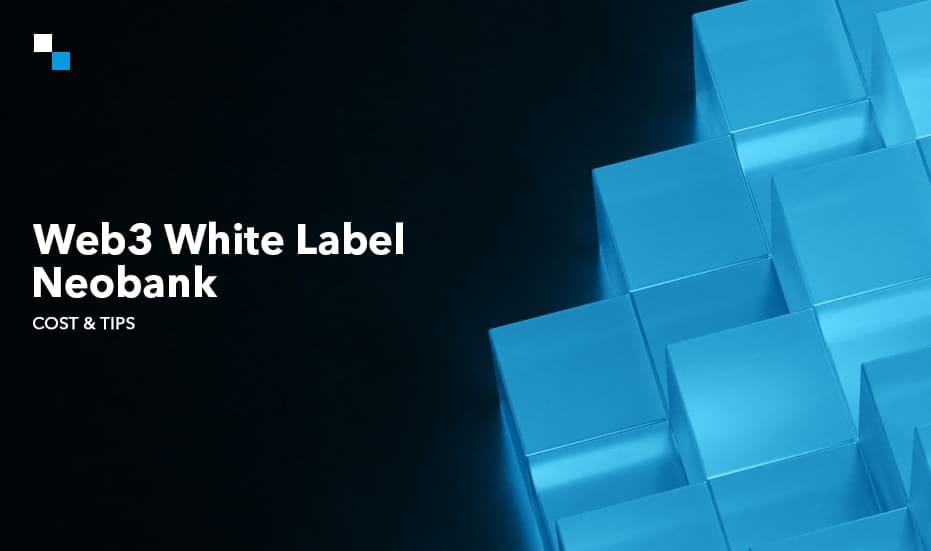Traditional banking models are being challenged by innovative Neobanks that provide streamlined digital experiences, lower fees, and personalised service. This idea is expanded upon by white-label Neobanks, which offer financial institutions a pre-built banking platform that they can alter and introduce under their own name. This methodology expedites time-to-market while curbing development expenses.
Though Web3 white label Neobanks have enormous potential, creating one will cost a large sum of money. Any Web3 Neobank project’s success depends critically on its ability to accurately estimate development costs. A thorough comprehension of costs is necessary to make wise decisions, efficiently manage finances, and turn a profit on an endeavour. This blog post will delve into the intricacies of evaluating costs for Web3 white-label Neobank development, providing essential insights for entrepreneurs, investors, and developers alike.
Are you ready?
Decoding the Cost Drivers: Key Factors Impacting Web3 White Label Neobank Development
1. Scope of the Project
The breadth and depth of your Web3 Neobank’s features significantly impact development costs. Core functionalities such as account opening, deposits, withdrawals, and transfers form the foundation. However, additional features like lending, borrowing, investing, and trading will increase complexity and costs.
- Basic features : These include essential banking services like account management, transfers, and card payments.
- Advanced features : These can encompass DeFi functionalities like lending, borrowing, and staking, as well as integrations with external financial services.
- Custom features : Unique features tailored to your target market can increase development time and costs.
2. Technology Stack Selection
The choice of technology underpinning your Neobank directly influences costs.
- Blockchain platform : Different platforms (Ethereum, Solana, Polygon, etc.) have varying development costs due to factors like transaction fees, scalability, and developer ecosystem.
- Programming languages : The proficiency of your development team and the availability of talent for specific languages (Solidity, Rust, JavaScript) will affect costs.
- Infrastructure : The underlying infrastructure, including servers, storage, and network bandwidth, impacts overall expenses.
3. Team Size and Expertise
The size and skill set of your development team are crucial determinants of costs.
- In-house team : Hiring and retaining skilled developers can be expensive, but offers greater control over the project.
- Outsourcing : Engaging external development firms can be cost-effective, but requires careful vendor selection and project management.
- Freelancers : Hiring freelancers offers flexibility but can pose risks in terms of project management and quality control.
4. Regulatory Compliance Considerations
Adherence to financial regulations is mandatory but can increase costs due to legal and compliance expertise.
- Licensing requirements : Obtaining necessary licenses and permits can be time-consuming and expensive.
- Data privacy : Complying with data protection regulations (GDPR, CCPA) requires additional measures and resources.
- Anti-money laundering (AML) and counter-terrorism financing (CTF) : Implementing robust AML/CTF procedures adds to development and operational costs.
5. Security Measures and Audit Requirements
Protecting user funds and data is paramount. Implementing robust security measures and undergoing regular audits increases expenses.
- Cybersecurity : Investing in encryption, firewalls, and intrusion detection systems is essential.
- Smart contract audits : Verifying the correctness and security of smart contracts is crucial to prevent vulnerabilities.
- Penetration testing : Identifying potential security weaknesses through simulated attacks adds to costs.
By carefully considering these factors, you can make informed decisions about your Web3 white label Neobank development project and allocate resources effectively.

Comprehensive Cost Breakdown: Building a Web3 White-Label NeoBank
1. Development Costs
Development is the core of your Web3 Neobank. It encompasses three primary areas:
- Front-end development : This involves creating the user interface (UI) and user experience (UX) that customers interact with. Costs include design, development, and testing of the website and mobile app.
- Back-end development : This is the foundation of your platform. It includes building the servers, databases, and APIs that power the front-end. Costs involve server infrastructure, programming, and integration with other systems.
- Smart contract development : These are self-executing contracts with the terms of the agreement directly written into code. Costs include designing, writing, testing, and deploying smart contracts on the blockchain.
2. Design and UI/UX Costs
A visually appealing and user-friendly interface is crucial for attracting and retaining customers. Design and UI/UX costs include:
- Visual design : Creating the look and feel of your platform, including branding, color schemes, and imagery.
- User interface (UI) design : Designing the layout and structure of the user interface for optimal user experience.
- User experience (UX) design : Ensuring the platform is intuitive and easy to navigate.
- Prototyping and testing : Creating interactive prototypes and conducting user testing to refine the design.
3. Blockchain Infrastructure Costs
The underlying blockchain infrastructure is essential for your white label Neobank’s operations. Costs include:
- Blockchain platform fees : Charges associated with using a particular blockchain platform (e.g., Ethereum, Solana).
- Node infrastructure : Costs for running blockchain nodes, including hardware, software, and network connectivity.
- Smart contract deployment : Fees for deploying smart contracts on the blockchain.
- Storage : Costs for storing data on the blockchain or off-chain.
4. Security and Audit Costs
Protecting user funds and data is paramount. Security and audit costs include :
- Security measures : Implementing firewalls, encryption, and other security protocols.
- Penetration testing : Assessing your system’s vulnerability to attacks.
- Smart contract audits : Verifying the correctness and security of smart contracts.
- Compliance audits : Ensuring adherence to regulatory requirements.
5. Legal and Compliance Costs
Navigating the complex legal and regulatory landscape is essential. Costs include:
- Legal counsel : Hiring lawyers to advise on legal matters and regulatory compliance.
- Licensing fees : Obtaining necessary licenses and permits.
- Regulatory compliance : Implementing procedures to comply with anti-money laundering (AML), know-your-customer (KYC), and other regulations.
6. Marketing and Launch Costs
Launching your Web3 Neobank requires effective marketing and promotional activities. Costs include:
- Branding and marketing materials : Developing your brand identity and creating marketing collateral.
- Advertising and public relations : Promoting your Neobank through various channels.
- Customer acquisition : Costs associated with acquiring new customers.
- Launch events : Organizing launch events or campaigns.
7. Ongoing Operational Costs
Once your Web3 white label Neobank is live, there are ongoing operational costs to consider:
- Staff salaries : Paying employees involved in customer support, operations, and development.
- Technology infrastructure maintenance : Upkeeping servers, software, and network infrastructure.
- Transaction fees : Costs associated with processing transactions on the blockchain.
- Customer support : Providing assistance to customers.
- Compliance monitoring : Continuously monitoring for regulatory changes.
By carefully analyzing these cost components, you can develop a comprehensive budget for your Web3 white label Neobank project.

Build Your Own Web3 White Label NeoBank in 5 Simple Steps
Step 1 : Identifying a White-Label Provider
Choosing the right Web3 white-label Neobank provider is crucial for the success of your platform. Look for a provider with a strong track record, robust technology infrastructure, and a comprehensive suite of features.
Key factors to consider :
- Experience in Web3 and blockchain technology
- Compliance with relevant regulations
- Customization options
- Pricing models
- Customer support
- Security measures
Step 2 : Customization Options and Pricing
A white-label platform offers a foundation, but customization is key to differentiating your Neobank. Explore the available customization options and understand the associated costs.
Customization possibilities :
- Branding elements (logo, color scheme, fonts)
- User interface and user experience (UI/UX)
- Feature selection (accounts, payments, lending, investments)
- Integrations (third-party services, APIs)
- Pricing models (subscription-based, transaction fees, revenue sharing)
Step 3 : Integration with Existing Systems
If you have existing systems, such as customer databases or payment gateways, seamless integration is essential. Ensure your white-label Neobank provider offers compatibility or can integrate with your systems.
Key integrations :
- Customer relationship management (CRM) systems
- Payment gateways
- Accounting software
- Fraud prevention systems
Step 4 : Branding and Marketing Strategies
Building a strong brand identity is crucial for attracting customers. Develop a comprehensive marketing strategy to create awareness and generate interest in your Neobank.
Branding elements :
- Logo design
- Brand story
- Value proposition
- Target audience
Marketing channels :
- Social media
- Content marketing
- Email marketing
- Partnerships and collaborations
- Influencer marketing
Step 5 : Launch and Post-Launch Considerations
A successful launch requires meticulous planning and execution. Develop a post-launch strategy to monitor performance, gather feedback, and make necessary adjustments.
Launch planning :
- Soft launch or full-scale launch
- Marketing campaigns
- Customer onboarding
- Technical support
Post-launch activities :
- User feedback analysis
- Performance monitoring
- Feature updates
- Customer support optimization
- Regulatory compliance
By following these steps and carefully considering each aspect, you can successfully build and launch your own Web3 white-label Neobank. Remember to conduct thorough research, choose the right partners, and prioritize customer satisfaction.

How Antier Can Help?
Building a Web3 white-label Neobank presents a significant opportunity to disrupt traditional banking. However, it requires careful planning, substantial investment, and a deep understanding of the evolving regulatory landscape. By meticulously evaluating development costs, selecting the right technology stack, and implementing robust security measures, you can lay the foundation for a successful venture.
Antier, a leading provider of web3 white label Neobank development services, can be your trusted partner. Our expertise in blockchain technology, coupled with a deep understanding of the financial industry, enables us to deliver tailored solutions that meet your specific requirements. From concept to launch, we provide comprehensive services including blockchain development, smart contract creation, UI/UX design, and security audits. By leveraging our capabilities, you can accelerate your time to market and focus on your core business objectives.
Contact us today for a free consultation to discuss your Web3 Neobank project!





